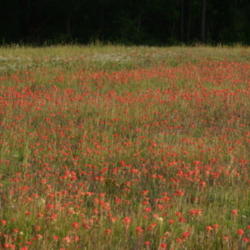
The beauty of wildflowers is they're easy to grow, colorful from spring until fall, they provide color for years with little maintenance, and they attract wildlife such as butterflies and birds to your yard.
Here's how to select and grow the right wildflowers for your area.
Types of WildflowersIt's best to grow the right type of wildflowers for your location. Wildflower seed mixes re often created for different regions of the country. These mixes are a blend of annual and perennial flowers and come in packages ranging from small tins to huge sacks. Although growing all one type of wildflower creates a more dramatic look, growing a mixture is insurance that some of the flowers will thrive. Annual flowers will dominate the mix the first year, and some may self-sow for a second year of flowers. Perennials will take over from the second year onward.
Another option is to plant wildflower seed mats. These contain a mix of annual and perennial flower seeds woven into a 5-foot-long mat. Just lay the mat over cultivated ground, water, and watch the flowers grow. The mat eventually decomposes. It's much simpler and less messy than sowing seeds, and it's great for creating small wildflower patches. The mats also come in themes, such as butterfly garden mats, that are filled with flowers to attract our winged friends.
When To Plant WildflowersWhile late summer and fall are the best times of year to plant many wildflowers, early spring also is an option, especially for wildflower mixes dominated by annual flowers. Also, if you live in USDA hardiness zones 3 to 6, sowing in spring insures perennial wildflowers will be well established to survive a harsh winter.
On the other hand, some warm-season native wildflowers, such as Texas bluebonnet and Indian blanket, need to be planted in late summer and fall for best growth. The winter rains and cool temperatures allow these plants to become established before spring. However, that shouldn't stop you from buying and giving these seed mixes to friends and family members this holiday season. The seeds, if stored in a dark, cool room, should be fine until sowing.
Planting TechniquesBe creative when planting wildflowers. While the most popular method is a meadow in the backyard, wildflowers can be grown in median strips along roadways, between fruit trees in the yard, or even as a replacement for your lawn in difficult to mow sections. Wherever you grow them, take time to prepare the soil first.
Wildflowers grow best in full sun on well-drained soil. The planting area should be only lightly cultivated. Don't cultivate the soil deeply or you'll bring up weed seeds that will compete with your wildflowers. Consider tilling a second time, one to two weeks after the initial cultivation, to kill any annual weeds that may have germinated. You can also use a flame weeder or an organic herbicide to kill the weeds before seeding. In small areas, try hand removing perennial weeds, such as dandelions and burdock, to reduce competition.
Once the soil is prepared, mix the wildflower seeds with sand or vermiculite to distribute them evenly. Use one (for larger seeds) to four (smaller seeds) parts sand to one part seed. When seeding, walk first in one direction, then in the other to get complete seed coverage. In small areas, walk over the planting bed several times to press the seeds into the soil. In larger areas, use a lawn roller. Once the seeds germinate, remove any obvious weeds, such as grasses. At the end of the season, mow down the wildflower patch to reduce weeds and spread the seeds from annual flowers. Next spring the flower show will return on its own.
Wildflowers IndoorsWhile just enjoying the wildflowers as they bloom is perfectly fine, some gardeners like to cut the flowers for indoor arrangements. The best time to harvest wildflowers for bouquets is in early morning. Use sharp clippers to cut off stems and to cut away leaves and dead or dying parts. Later, recut the stems at an angle to the length desired. Don't remove all the flowers, though; leave some to make seeds for next year.
 Charlie Nardozzi is an award winning, nationally recognized garden writer, speaker, radio, and television personality. He has worked for more than 30 years bringing expert gardening information to home gardeners through radio, television, talks, tours, on-line, and the printed page. Charlie delights in making gardening information simple, easy, fun and accessible to everyone. He's the author of 6 books, has three radio shows in New England and a TV show. He leads Garden Tours around the world and consults with organizations and companies about gardening programs. See more about him at Gardening With Charlie.
Charlie Nardozzi is an award winning, nationally recognized garden writer, speaker, radio, and television personality. He has worked for more than 30 years bringing expert gardening information to home gardeners through radio, television, talks, tours, on-line, and the printed page. Charlie delights in making gardening information simple, easy, fun and accessible to everyone. He's the author of 6 books, has three radio shows in New England and a TV show. He leads Garden Tours around the world and consults with organizations and companies about gardening programs. See more about him at Gardening With Charlie.